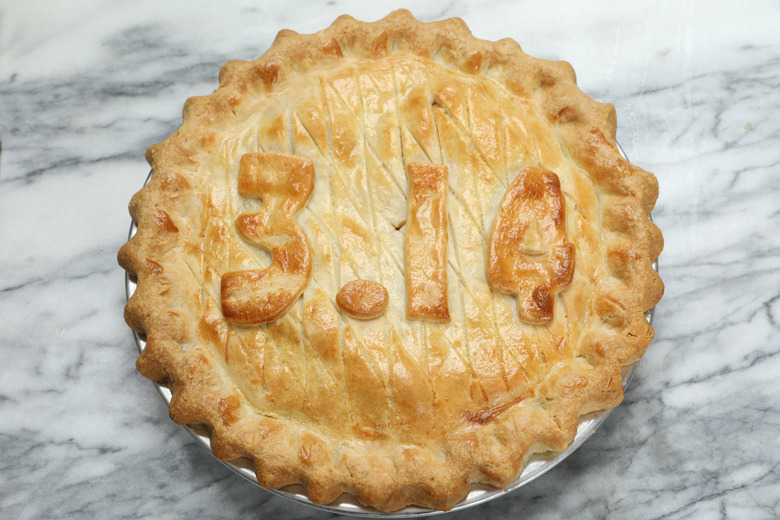Happy Pi Day! 3 Simple Ways To Estimate Pi
March 14 (3/14) is Pi Day (not to mention Albert Einstein's birthday), and it's become such an important event that it was officially recognized by the U.S. House of Representatives in 2009.
There are many ways you can celebrate the occasion, from the easiest and most fun (baking an actual pie, with the π symbol on the top for good measure) to the more mathematical and interesting. Here at Sciencing, we'll never discourage you from making a pie, but there are many other unique activities you might enjoy while it's baking or after you've eaten a slice or two.
Although people have known about pi for over 4,000 years, getting better and better approximations for the infinitely extending decimals was historically one of the main tasks mathematicians took up. Of course, you'll never get to the 31 trillion digits currently known, but you can use some unique methods to get a pretty close approximation to the famous number.
The Rectangle Method
This approach is more hands-on than the others on this list, so you'll need a compass and pencil, a piece of paper or card, a ruler, scissors and a protractor. First, draw a circle on your piece of card, making sure you know the radius. Next, divide the circle into 12 equal sectors (like pizza slices), and pick one of these to divide again into two equal parts to give 13 sectors in total.
Cut the circle out, and cut out the sectors. Rearrange the sectors into the shape of a rectangle, with the straight edge of the smaller sectors at either short edge, and the thin end of one piece slotted neatly between the curved ends of the two neighboring pieces. The height of the rectangle is the radius of the circle, and the width is half of the circumference of the original circle.
Since circumference = 2 × π × radius, we have:
\(\text{Width} = π × \text{radius}\)
And you can estimate pi with:
\(π=\frac{\text{width}}{\text{radius}}\)
So all you need to do is measure the long side of the rectangle and divide by the radius to get an approximation for pi.
Archimedes’ Polygon Approximation for Pi
Archimedes used a simple but powerful method to approximate the value of pi, essentially surrounding a circle with two polygons, one just inside and one just outside the line of the circle. The circumference of the circle has to be between the circumference of these two polygons, and you can work pi out based on this. The approximation gets better and better as you add more sides to the polygons (see Resources for an example).
You can use one of two methods to do this for yourself. Most simply, you can draw the polygons for yourself and either use trigonometry to find or literally measure the circumference, then divide the result by 2r (i.e. 2 times the radius of the circle) to find the bounds for pi (with the inner shape giving the minimum and the outer one giving the maximum.
Alternatively, use a simple formula based on a circle with a diameter of 1 (i.e. r = 1/2):
\(π = \sin \bigg(\frac{θ}{2}\bigg) n\)
Where θ is the angle at the center of one of the triangular sections of the shape, and n is the number of sides. So if you're using a 20-sided polygon, you simply divide 360° (a complete circle) by 20 to find θ.
Buffon’s Needle
One of the most ingenious methods for estimating pi is called Buffon's needle, named after the French philosopher Georges-Louis Leclerc, Comte de Buffon, who discovered the approach. Get a piece of paper and draw a set of equally spaced parallel lines on it, with a distance between them we'll call d, then drop many sticks on the piece of paper. The key to this approach is using sticks with a length l that is less than the distance between the lines, so if you're using matchsticks, you should make sure you separate the lines by more than the length of a matchstick.
You can estimate pi based on:
\(π = \frac{2ls}{cd}\)
where l and d are as defined above, s is the total number of sticks you've dropped onto the paper, and c is the number of sticks that cross a line. This is a statistical approach to finding the answer, so the more sticks you drop, the better the estimation you'll get. It's actually a form of Monte Carlo simulation for finding the value of pi.
If this seems like a lot of work (and cleaning up!), there is an online version you can use to simulate the experiment (see Resources).
Cite This Article
MLA
Johnson, Lee. "Happy Pi Day! 3 Simple Ways To Estimate Pi" sciencing.com, https://www.sciencing.com/facts-about-pi-13725414/. 13 March 2020.
APA
Johnson, Lee. (2020, March 13). Happy Pi Day! 3 Simple Ways To Estimate Pi. sciencing.com. Retrieved from https://www.sciencing.com/facts-about-pi-13725414/
Chicago
Johnson, Lee. Happy Pi Day! 3 Simple Ways To Estimate Pi last modified March 24, 2022. https://www.sciencing.com/facts-about-pi-13725414/
